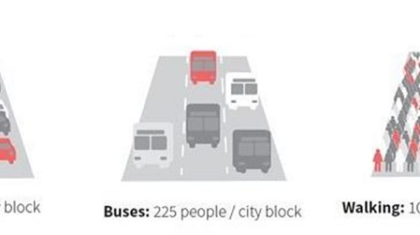
by Ryan Johnson, Planner, Alta Planning + Design
I recently returned from a two-week trip to Europe, and I obviously spent a lot of time observing pedestrian and bicycle culture and infrastructure. Rather than simply envy our neighbors across the pond for their walkable and bike-friendly cities and believe that we Yanks could never match their high active transportation mode shares, I was constantly thinking how I could translate my experiences and observations into on-the-ground change here in the U.S. I also realized that we have some progressive transportation infrastructure on our own soil to be proud of.
We first made the pilgrimage to Copenhagen — the Promised Land for many Americans in the bicycle/pedestrian profession… And it lived up to the hype! The comprehensive network of physically separated cycle tracks was incredible and refreshing, of course, but I was more impressed by how easy it was to walk around the city. Several of the major streets were actually pedestrianized, with motor vehicles prohibited. While some examples of this concept exist in the U.S. — including Santa Monica’s Third Street Promenade — they feel rather manufactured and not organic.

Even with the dreary weather, we were sad to leave the playground of Copenhagen. But Paris was awaiting us! I had a mental image of Paris as the small, charming town along the river that is shown in films and travel magazines. However, I was immediately made aware of the city’s sprawling size and wide, auto-clogged boulevards. In a way, I was reminded of my hometown of Los Angeles, except that Paris’s Metro system blankets the region. In a flip from my experience in Copenhagen, I had gone to Paris expecting a walker’s paradise, but instead saw a budding cycling haven. The city had already squeezed cycle tracks along many of the major boulevards, and the famous Vélib’ public bicycles were as common a sight as sidewalk cafés and baguettes. The bicycle network appears set up to help Parisians close the “first mile/last mile gap” that often exists in a trip using public transit. I would love to see Los Angeles and other U.S. cities with mass transit networks pursue a similar course.

Finally, we ended our vacation by hanging out in the pedestrian paradises that are old Spanish cities. Barcelona, our first stop, was seemingly built to make walking a pleasurable experience, with interesting side streets, promenades, and commercial districts around every corner. Barcelona and other Spanish cities like Granada and Toledo also make good use of shared streets, or woonerfs, to make streets safe in constrained neighborhoods.

Finally, the many plazas and parklets in Spain’s cities were a never-ending source of resting space and excellent people watching.

Although very different in many ways, Los Angeles can and should follow the lead of European cities by creating safe and pleasurable spaces for people to walk or bike and be outside enjoying our near-perfect weather. And I’m proud to say that the LA region is beginning to seriously take on that mission. Both Long Beach and Temple City now have cycle tracks. LA County Metro is planning a regional bike share program. And through the LA Department of Transportation’s People St. program, several plazas and parklets have been created or are planned for previously underused road space. I’m excited that our leaders are beginning to push for progressive changes to restore some balance to how we move around our own cities.



